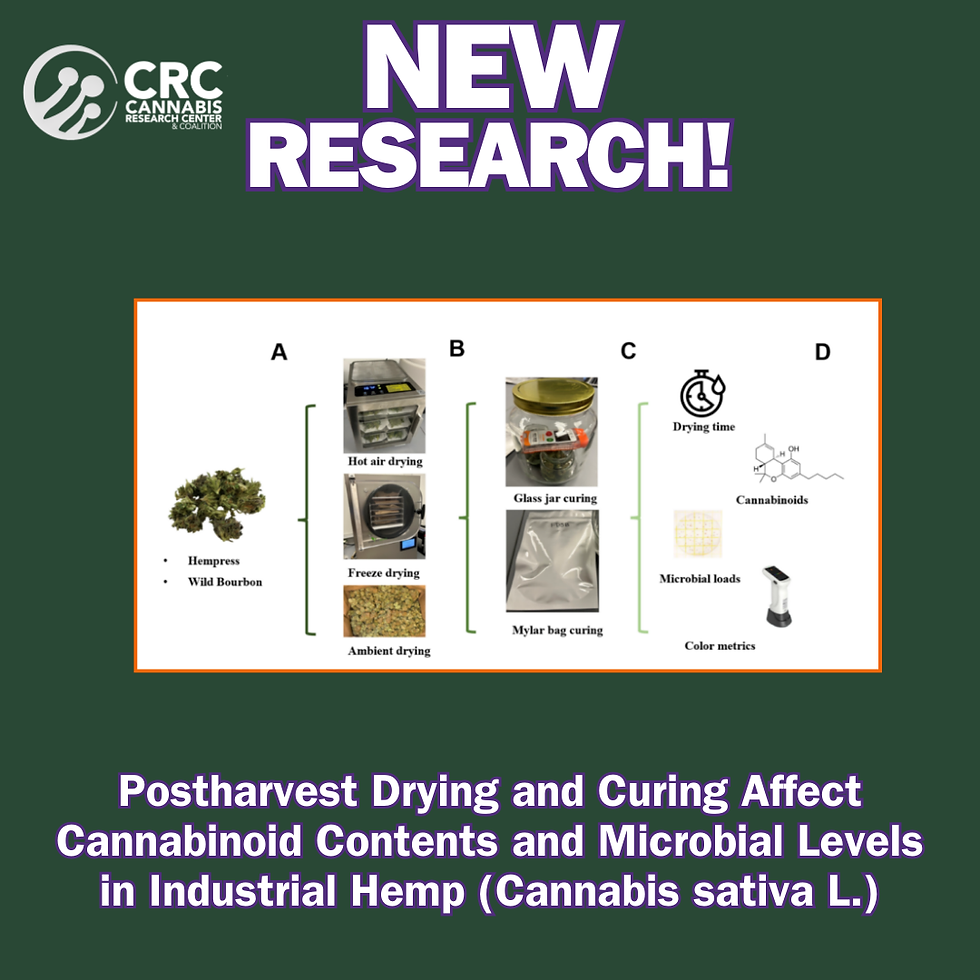authors
Yousoon Baek 1, Heather Grab 1 and Chang Chen 2,*
1 School of Integrated Plant Science, Horticulture Section, Cornell University, Ithaca, NY 14853, USA;yb273@cornell.edu (Y.B.); heathergrab@psu.edu (H.G.)
2 Department of Food Science, Cornell AgriTech, Cornell University, Geneva, NY 14456, USA
* Correspondence: cc2774@cornell.edu; Tel.: +1-315-787-2286

Practical Breakdown Postharvest drying and curing are critical processes that affect the quality, safety, and cannabinoid content of industrial hemp. While drying techniques for many agricultural crops are well established, hemp processing is still being refined through scientific research. This study explores how different drying and curing methods impact hemp’s overall quality, focusing on moisture content, cannabinoid stability, and microbial safety.
This research examines three drying methods: hot air drying at 75°C, ambient air drying at 25°C, and freeze drying. Post-drying, the hemp was cured in either sealed glass jars or Mylar bags under dark conditions. The study measured changes in moisture, cannabinoid composition, and microbial loads to determine the most effective post harvest strategy for hemp processors.
Key Findings
Efficiency of Drying Methods:
Hot air drying rapidly reduced moisture to 6% in 8 hours while significantly lowering microbial contamination.
Ambient air drying took one week and resulted in higher microbial loads.
Freeze drying preserved color and cannabinoids but required 24 hours to complete.
Effects of Curing:
Curing increased moisture content slightly (3.3% to 13.6%), helping to rehydrate dried hemp.
Total cannabinoid content remained stable, though some decarboxylation occurred, activating more THC and CBD.
Glass jars were superior to Mylar bags for maintaining cannabinoid stability and microbial safety.
Microbial Safety:
Hot air drying reduced yeast and mold counts the most, improving overall safety.
Curing did not significantly increase microbial risks when performed under controlled conditions.
Application for Hemp Processors
Proactive Postharvest Management:
Avoid waiting for visible signs of degradation before adjusting drying and curing methods.
Regularly monitor and optimize drying conditions to ensure consistency and product safety.
Recommended Drying & Curing Approach:
For speed and microbial control, hot air drying is the best method.
For premium flower preservation, freeze drying offers the best quality but requires more time and resources.
Curing is essential for achieving optimal moisture balance and improving overall flower quality.
Glass jars are preferred over Mylar bags for long-term storage, ensuring better cannabinoid retention and microbial safety.
Limitations of the Study
The study focused on only two hemp varieties, so findings may not apply universally.
The curing period was limited to three weeks, leaving long-term effects unexplored.
Only yeast and mold contamination were assessed, meaning other microbial risks remain unknown.
Humidity fluctuations during curing were not tightly controlled, potentially affecting outcomes.
Final Takeaway
Maximizing hemp quality and safety depends on selecting the right drying and curing methods. Hot air drying is the fastest and safest method for large-scale production, while freeze drying is ideal for premium flower preservation. Proper curing, particularly in glass jars, ensures long-term stability. By refining these techniques, hemp processors can enhance product consistency, safety, and potency.
DOWNLOAD THE FULL PUBLICATION
.png)
Comentários